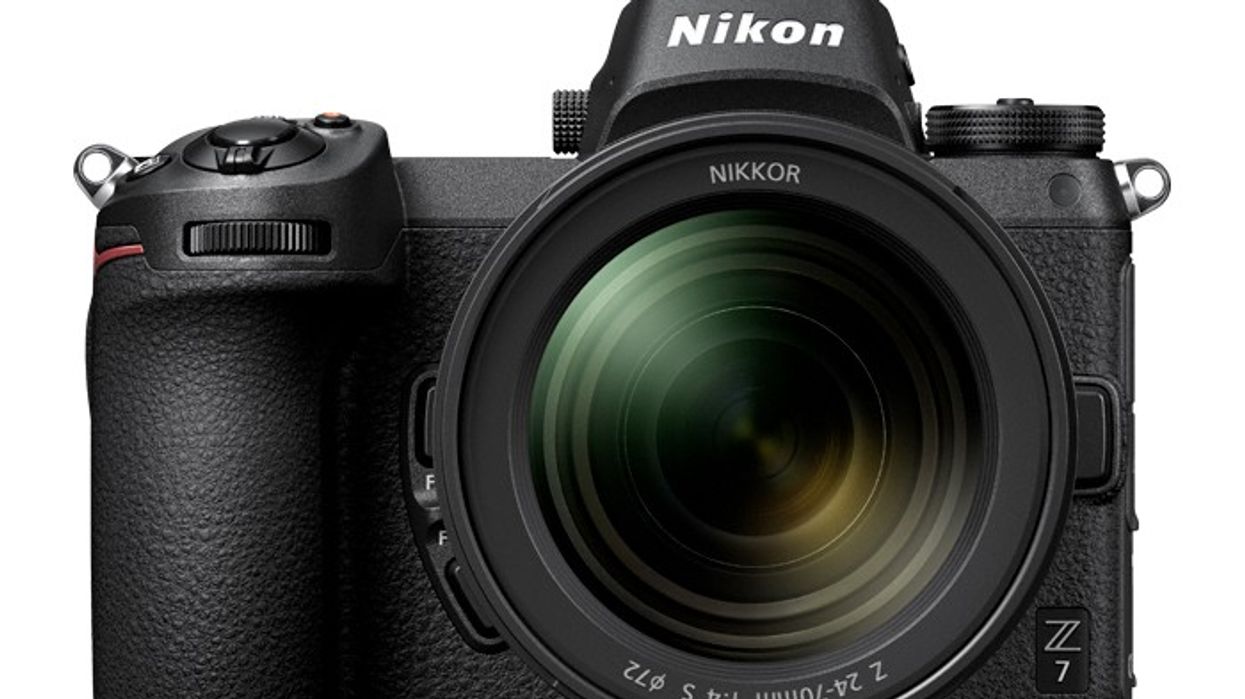Nikon Z7 & Z6 Mirrorless Cameras Officially Announced
After weeks of speculation and rumors, here's what we know about the Nikon Z7 and Z6 mirrorless cameras.

Nikon has been around since 1917, introducing the Nikon I in 1948, the Nikon F in 1959 (its first SLR camera with interchangeable lenses) and the Nikon D1 in 1999. The D850 has become its DSLR flagship.
Now the company is going mirrorless with its Z7 and Z6 cameras and new Z mount lenses. During a live stream event, Nikon introduced both cameras, four new lenses, and a new lens adapter into its ecosystem while teasing a future lens roadmap.
Sensor
Both Z7 and Z6 have a backside illuminated FX-format CMOS sensor (35.9mm x 23.9 mm) and tout its latest image processing engine EXPEED 6, which Nikon says "subjects are rendered more sharply than ever before" and "noise is also effectively reduced." The focal flange distance is 16mm and the inner mount diameter measures 55mm, allowing for apertures as fast as f/0.95 (a NIKKOR Z 58mm f/0.95 S Noct lens is in development, but more on that later).
Both cameras feature focal-plane phase-detection AF pixels— 493 for the Z7 and 273 for the Z6—covering "approximately 90% of the imaging area both horizontally and vertically." The AF switches automatically between focal-plane phase-detection AF and contrast-detect AF.
A mid-range sharpening tool has been added to Picture Control. This allows shooters to make "various textures within the screen sharper or softer, for both still images and movies." You must be shooting at "High Quality" in video mode to use the tool.

Both cameras are the same size and weight, have completely silent shooting modes, and feature a weather-sealed construction. Both have a 3.2" tilting touchscreen LCD (2.1 million-dot) with a 170° viewing angle, an OLED electronic viewfinder with 100% frame coverage and 0.8x magnification, top display, built-in Bluetooth and Wifi for data transfer, and a single QXD memory card slot.
Additionally, a 5-axis stabilizer is outfitted on both, along with 4K UHD 30p, FHD 120p internal recording, a new N-log color profile that's supposed to have 12 stops of dynamic range, and the ability to send a 4:2:2 10-bit signal through its HDMI output. If you're wondering if you can simultaneously record internally and externally, it's unfortunately not possible.
There's also a 3.5mm audio input, Active D-Lighting, electronic vibration reduction, and focus peaking for 4K UHD and full HD movie recording. Here are the main spec differences:
Z7: 45.7 MP, 493 AF Points, ISO 64-25600, 9 FPS
Z6: 24.5 MP, 273 AF Points, 100-51200 ISO, 11 FPS
Video
In terms of video specs, both cameras shoot the same resolutions and frame rates: full frame, no crop up to 4K UHD 30p, and full HD at 120p. For 4K UHD, you get frame rates of 30, 25, and 24. For full HD, you get those and 50, 60, 100, and 120 fps. Slow-mo offers 30 fps x4, 25 fps x4, and 24 fps x5 respectively. Video files are MOV/MP4 with a H.264/MPEG-4 compression. Nikon also mentions that the camera offers timecode support.
Lenses
Three new lenses were announced: NIKKOR Z 24-70mm f/4 S, NIKKOR Z 35mm f/1.8 S, and NIKKOR Z 50mm f/1.8 S. All three can be used directly with the Z mount system with more in development. Each lens received a new designation grade dubbed S-Line which Nikon says "clear stricter quality standards."

- 0.3 m minimum focus distance
- ED glass element, an aspherical ED lens element, three aspherical lens elements
- Nano Crystal Coat to reduce ghost and flare
- Weather sealed
- Fluorine coat

- Two ED glass elements, three aspherical lens elements
- Nano Crystal Coat to reduce ghost and flare
- Weather-sealed

- Two ED glass elements, two aspherical lens elements
- Nano Crystal Coat to reduce ghost and flare
- New, powerful stepping motor for improved AF control
- Weather-sealed

- Designed based on the original AI Noct-Nikkor 58mm f/1.2 from 1977
- Manual focus lens
- 58mm
- f/0.95

Confirming what we learned from an earlier teaser video, those with F-mount lenses will be able to adapt to the Z7 & Z6 cameras via the FTZ adapter. During the presentation, they mentioned roughly 360 F lenses will be compatible.
AE or AF/AE shooting will be available along with its in-camera VR (Vibration Reduction) in video or still mode.

Price & Availability
The Z7 will be available in September for $3,399. and the Z6 slated for October for $1,995. A 24-70mm kit will be available for $3,999 and $2,599. The lenses: 24-70mm ($999) and 35mm ($845) will be available in September. The 50mm ($599) will launch in October. As for the FTZ adapter, it runs $250.
Z7 Tech Specs:
- 45.7 MP
- 493 AF Points
- ISO 64-25600
- 9 FPS
- 5-axis stabilization
- 4K UHD 30p, FHD 120P
- 4:2:2 10-bit HDMI output
- N-Log color profile
Z6 Tech Specs:
- 24.5 MP
- 273 AF Points
- 100-51200 ISO
- 11 FPS
- 5-axis stabilization
- 4K UHD 30p, FHD 120P
- 4:2:2 10-bit HDMI output
- N-Log color profile
Source: Nikon





 No Film School's coverage of
No Film School's coverage of 









